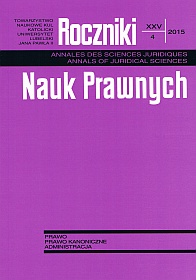The Guarantee of Justice and Reform of the Process of Marriage as seen Through the Prism of Necessity its Acceleration and Facility the Faithful. The Contact with a Tribunal; Preparation of Employees and the Responsibility of the Bishop
Abstract
The article concerns the issues relating to the need to make more efficient; more accessible and possibly totally free of charge process leading to the declaration of the nullity of marriage; the preparation of tribunal’s employees and the responsibility of the diocesan bishop.
At the beginning the author presented the proposals of Relatio Synodi (no. 48 and 49) with regard to the above mentioned issues. They are confronted with the changes introduced to the canonical process for cases of the nullity of marriage; introduced by Pope Francis in motu proprio Mitis Iudex Dominus Iesus and Mitis et Misericors Iesus that were signed on August 15; 2015 and published on September 8; 2015. The paper discusses the reception – in the mentioned documents – the reform of Pope Francis proposals contained in the final document Relatio Synodi of Extraordinary Assembly of the Synod of Bishops in October 2014.
The analysis shows that it has been upheld as a fundamental principle which implies to find the objective truth concerning the validity of the bond. With this particular reason; mercy can never ignore the truth. Successively various ways are indicated (often unused) that offered law previously in force; which made the procedure for the examination of nullity of marriage more accessible and more agile; and also is discussed the issue concerning the court costs and free service.
The same issues are then analyzing and presenting in the light of the new regulations. In turn; the author stops on the issue of the preparation of employees; clerics and lay persons paying attention to the duties and responsibility of the diocesan bishop. In conclusion the author tries to answer the question of how the new regulations guarantee observance of justice in the process of marriage.
References
Bonnet Piero Antonio; Gullo Carlo (red.): La «Lex propria» del S. T. della Segnatura Apostolica; (Studi Giuridici 89); Città del Vaticano 2010.
Burke Leo Raymond: La procedura amministrativa per la dichiarazione di nullità del matrimonio; [w:] I procedimenti speciali nel diritto canonico; (Studi Giuridici 27); Città del Vaticano 1992; s. 93-104.
Erlebach Grzegorz: Gli aspetti procedurali del “processus brevior” nella giurisprudenza rotale; „Periodica de re canonica” 88 (1999); s. 725-753.
Malecha Paweł: I tribunali interdiocesani alla luce dei recenti documenti della Segnatura Apostolica. Alcune considerazioni pratiche; „Ius ecclesiae” 24 (2012); s. 183-208.
Malecha Paweł: „Processus brevior”: istotne jego elementy i niektóre spostrzeżenia praktyczne; [w:] Wybrane zagadnienia procesu małżeńskiego w XXX-lecie Kodeksu Jana Pawła II. VI Ogólnopolskie Forum Sądowe; Biblos; Tarnów 2014; s. 11-26.
Malecha Paweł: Commissioni pontificie e proroghe di competenza nelle cause di nullità del matrimonio alla luce della recente giurisprudenza della Segnatura Apostolica; „Ius ecclesiae” 23 (2011); s. 205-251.
Malecha Paweł: Le dispense dalle leggi processuali alla luce di recenti documenti della Segnatura Apostolica. Alcune considerazioni pratiche; „Ius ecclesiae” 25 (2013) s. 239-260.
Montini Gian Paolo: La prassi delle dispense da leggi processuali del Supremo Tribunale della Segnatura Apostolica (art. 124; n. 2; 2a parte; Cost. Ap. „Pastor bonus”); „Periodica de re canonica” 94 (2005); s. 43-117.
Montini Gian Paolo: L’appello in una causa di nullità matrimoniale; „Quaderni di diritto ecclesiale” 22 (2009); s. 318-334.
Punderson Joseph R.: Accertamento della verità «più accessibile e agile»: preparazione degli operatori e responsabilità del vescovo. L’esperienza della segnatura apostolica; „Quaderni di ius missionale” 6 (2015); s. 88-90.
Salerno Francesco: La doppia sentenza conforme nel processo matrimoniale canonico: ipotetici precedenti medievali; [w:] Verità e definitività della sentenza canonica; (Studi Giuridici 46); Città del Vaticano 1997; s. 7-10.
Copyright (c) 2015 Roczniki Nauk Prawnych

This work is licensed under a Creative Commons Attribution-NonCommercial-NoDerivatives 4.0 International License.


